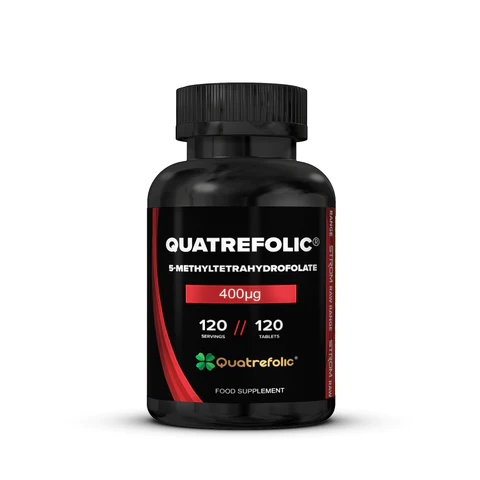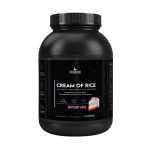Free shipping from € 250,-
Strom – Quatrefolic® (methylfolate) – 120 servings
High-quality methylfolate supplement, with a high dose of Quatrefolic® (Methylfolate)(5-MTHF) of 400μg.
QUATREFOLIC® VS. FOLIUM ACID
The body cannot use folic acid directly-it has to go through a conversion process to a form called Methyltetrahydrofolate (MTHF) to use it. Quatrefolic® does not have to go through the same conversion process as folic acid, effectively bypassing that genetic variation.
Take one tablet per day.
Binnenkort weer op voorraad
Please inform me when product is back in stock.




| Country | Via | Working days | Shipping costs | Free from |
|---|---|---|---|---|
| Netherlands | PostNL | 1 | € 6,95 | € 60,- |
| * Possible supplement for Wadden Sea islands | ||||
| Belgium | PostNL | 1 | € 6,95 | € 60,- |
| Luxembourg | PostNL DPD | 1-2 | € 9,95 | € 250,- |
| France | DPD | 2-3 | € 9,95 | € 250,- |
| * Possible supplement for remote areas and islands (Corsica) | ||||
| Italy | DPD | 3 | € 19,95 | € 250,- |
| * Possible supplement for remote areas and islands (Sicily, Sardinia) | ||||
| Spain | DPD | 3 | € 19,95 | € 250,- |
| * Possible supplement for remote areas and islands (Balaeren, Canary Islands) | ||||
| Germany | PostNL DPD | 3 | € 7,95 | € 100,- |
| * Possible supplement for remote areas and islands | ||||
| Portugal | DPD | 4 | € 19,95 | € 250,- |
| * Possible supplement for remote areas and islands (Azores, Madeira) | ||||
| Denmark | PostNL DPD | 2-3 | € 9,95 | € 250,- |
| * Possible supplement for remote areas and islands (Greenland, Faraör Islands) | ||||
| Bulgaria | DPD | 5 | € 19,95 | € 250,- |
| Estonia | DPD | 4 | € 19,95 | € 250,- |
| * Possible supplement for remote areas and islands | ||||
| Finland | DPD | 4 | € 19,95 | € 250,- |
| * Possible supplement for islands (Aland Islands) | ||||
| Greece | DPD | 7 | € 19,95 | € 250,- |
| * Possible supplement for remote areas and islands (Crete) | ||||
| Hungary | DPD | 3 | € 9,95 | € 250,- |
| Ireland | DPD | 3 | € 19,95 | € 250,- |
| * Possible supplement for remote islands (Northern Ireland) | ||||
| Croatia | DPD | 5 | € 19,95 | € 250,- |
| * Possible supplement for remote areas and islands | ||||
| Latvia | DPD | 4 | € 19,95 | € 250,- |
| Lithuania | DPD | 4 | € 19,95 | € 250,- |
| Austria | DPD | 2 | € 9,95 | € 250,- |
| Poland | DPD | 3 | € 9,95 | € 250,- |
| Romania | DPD | 4 | € 19,95 | € 250,- |
| Slovenia | DPD | 2-3 | € 39,95 | N/A. |
| Slovakia | DPD | 3 | € 19,95 | € 250,- |
| Czech Republic | DPD | 3 | € 9,95 | € 250,- |
| Sweden | DPD | 3 | € 19,95 | € 250,- |
| * Possible supplement for remote areas | ||||
Nice goodies with every order:
Alpha Supps - Gym Backpack Patch
Free with spendings from € 100
Alpha Supps - Shaker
Free with spendings from € 150
Alpha Supps - Wrist Wraps
Free with spendings from € 250
Supplement Needs - Cream of
Rice (Bday cake)
Free with spendings from € 350
Available samples of supplements will be manually added to your order if in stock. The higher the purchase amount, the more goodies. Above €350, you will therefore receive 5 goodies. The products are automatically added at checkout.


 10X Athletic
10X Athletic Alpha Designs
Alpha Designs Alpha Lion
Alpha Lion Applied Nutrition
Applied Nutrition Axe & Sledge
Axe & Sledge Chaos Crew
Chaos Crew Ghost
Ghost Complete Strength
Complete Strength Conteh Sports
Conteh Sports Muscle Rage
Muscle Rage HR Labs
HR Labs Per4m
Per4m Professor Nutz
Professor Nutz Project AD
Project AD Project AD
Project AD Pure Labs Nutrition
Pure Labs Nutrition RAW Nutrition
RAW Nutrition Rabeko
Rabeko Redcon1
Redcon1 Revive MD
Revive MD Ryse Supplements
Ryse Supplements Supplement Needs
Supplement Needs Strom Sports Nutrition
Strom Sports Nutrition Trained by JP
Trained by JP Zoomad Labs
Zoomad Labs





 Webshop Keur
Webshop Keur